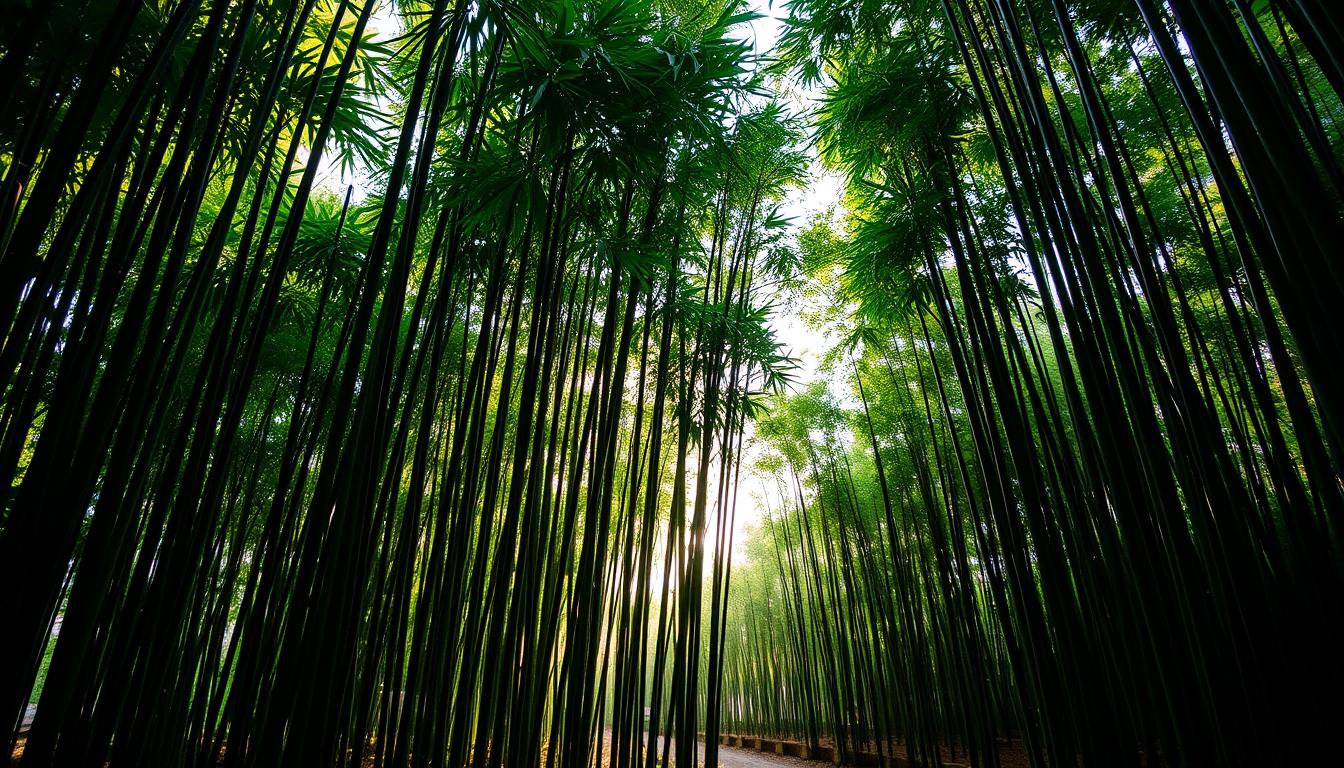Bamboo is called “the green gold” because it grows fast. It’s a type of grass that belongs to the Poaceae family. There are over 1,500 known species, found almost everywhere except Antarctica.
This amazing plant grows quickly and is very useful. It’s used in building, making furniture, and even in food. Bamboo has been important in many cultures, especially in China, Japan, and Nepal.
Key Takeaways
- Bamboo is a diverse plant with over 1,500 known species, each with unique characteristics and uses.
- Some bamboo species can grow up to 36 inches in a single day, showcasing its rapid growth rate.
- Bamboo forests contribute to carbon sequestration and help prevent soil erosion, making them important for environmental conservation.
- Bamboo provides livelihoods to millions of people worldwide, especially in rural and marginalized communities.
- Bamboo can be used to create a variety of products, demonstrating its versatility.
The Versatile World of Bamboo
A Brief Overview
Bamboo is a remarkable plant known for its versatility and sustainability. It has over 1,600 species worldwide. Bamboo forests cover 35-50 million hectares, making it a global phenomenon.
A bamboo grove releases 35% more oxygen than trees. This shows its important role in saving the environment.
The tallest bamboo can grow over 30 meters tall. The fastest-growing types can grow 36 inches in just 24 hours. Bamboo grows fast, reaching full size in 4 to 8 years.
Bamboo’s Diverse Applications
Bamboo is used in many ways, with over 10,000 documented uses. In construction, it’s used for scaffolding, bridges, and buildings. Its strength-to-weight ratio is impressive.
Furniture made from bamboo is durable, stylish, and eco-friendly. It’s a favorite among those who care about the environment.
Bamboo fibers make soft, breathable, and moisture-wicking textiles. It’s a sustainable alternative to cotton. Bamboo pulp is used to make paper products, reducing wood pulp demand and deforestation.
In culinary arts, bamboo shoots are a tasty and nutritious ingredient in Asian dishes.
Bamboo is also loved by artisans for making baskets, mats, and decorations. Its flexibility and strength are ideal for crafts. Bamboo helps the environment too, with its roots preventing soil erosion and helping to sequester carbon.
“Bamboo is not just a plant, it’s a symbol of strength, resilience, and sustainability.”
The Rich Cultural Heritage of Bamboo
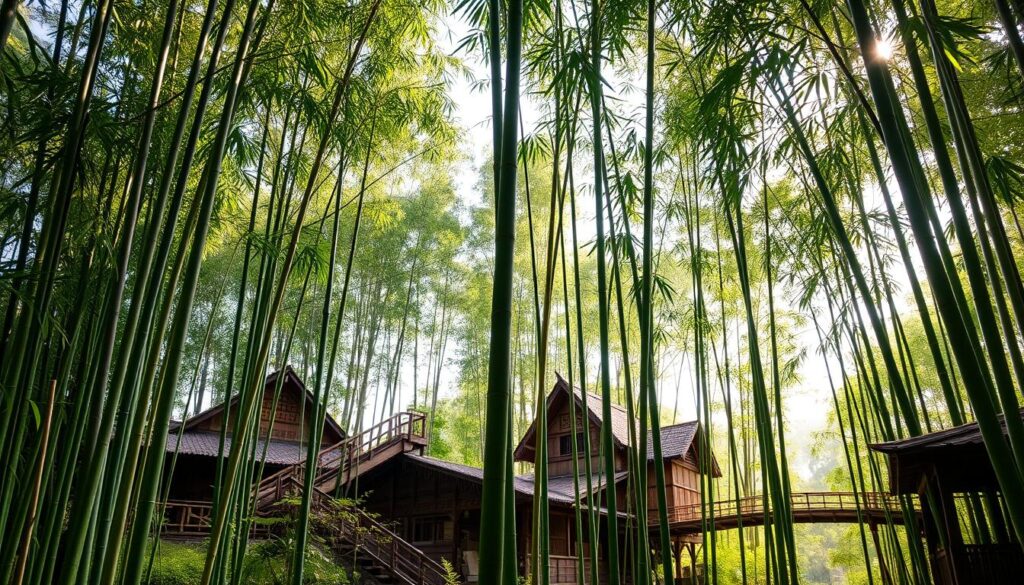
Bamboo has been important in many cultures for a long time. China is known as the “land of bamboo.” It symbolizes strength, flexibility, and resilience there. In Japan, bamboo is used in tea ceremonies, showing harmony with nature.
In India and Southeast Asia, bamboo is also very significant. In India, it’s used in building homes and religious places. Many indigenous communities in Southeast Asia depend on bamboo for their homes and tools.
| Country | Bamboo Significance |
|---|---|
| China |
|
| Japan |
|
| India |
|
| Southeast Asia |
|
Bamboo’s lasting impact in China, Japan, India, and Southeast Asia shows its great value. It’s used in many ways, from building homes to making crafts. Bamboo is a big part of the cultural heritage in Asia.
World Bamboo Day: Celebrating Sustainability
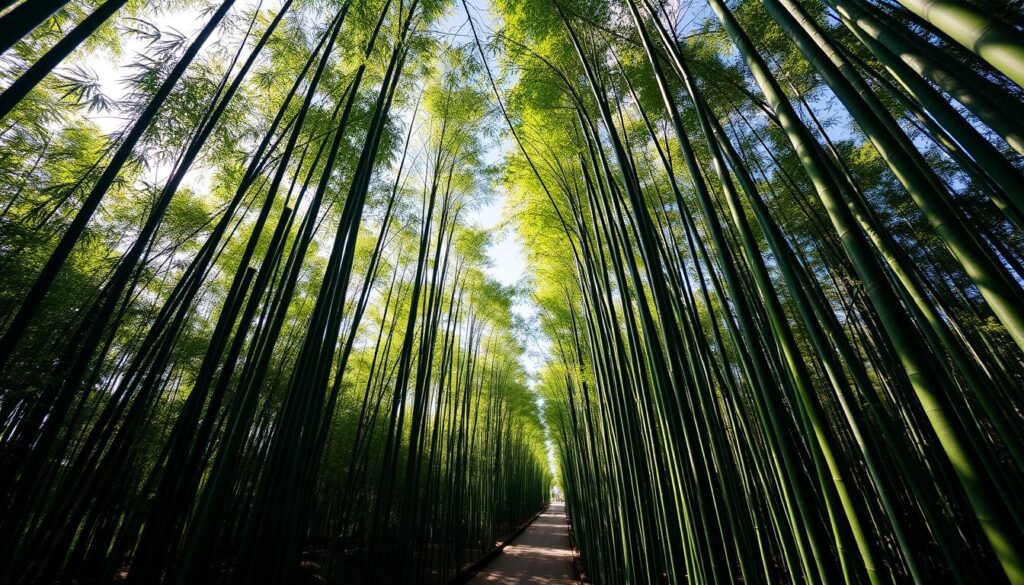
World Bamboo Day is a global event to highlight bamboo’s potential. It’s celebrated on September 18th by the World Bamboo Organization (WBO). This day is crucial for our planet.
The Significance of World Bamboo Day
Bamboo is a symbol of sustainability. It grows fast and can be harvested without harming the environment. Bamboo forests also help fight climate change by absorbing carbon dioxide.
Bamboo helps people in rural areas by providing jobs. It aids in reducing poverty. This shows bamboo’s role in creating economic opportunities.
World Bamboo Day promotes innovation in bamboo products. It’s a time for cultural exchange, bringing people together to celebrate bamboo’s uses and importance.
Bamboo has many environmental benefits. It releases more oxygen than trees, improving air quality. Bamboo also prevents soil erosion and reduces the need for harmful fertilizers.
World Bamboo Day shows bamboo’s power in solving global problems. It aims to make us more aware of bamboo’s benefits. This celebration seeks a greener and fairer future.
Bamboo Forests: Nature’s Green Giants
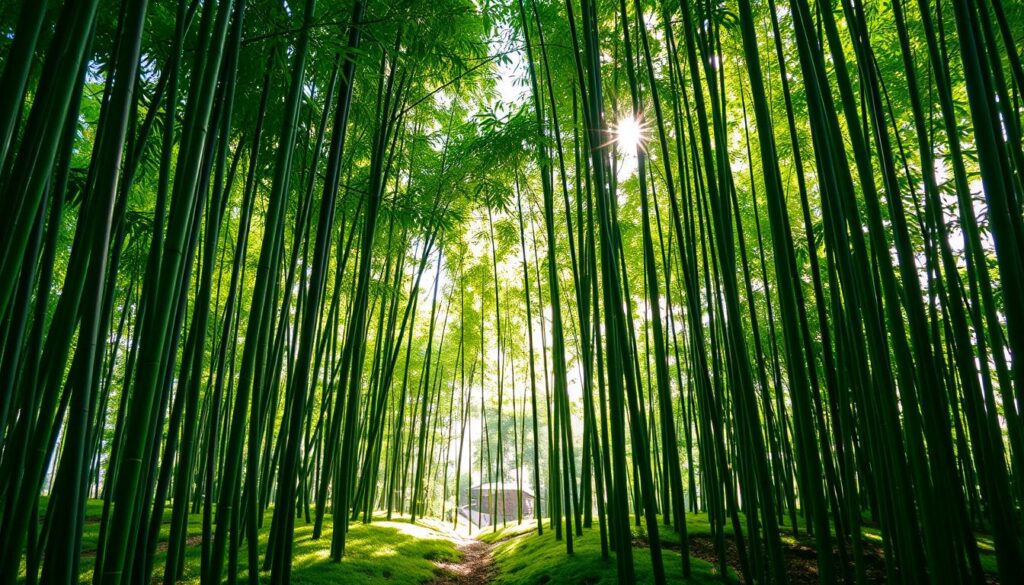
Bamboo forests are called “nature’s green giants” for good reason. They are amazing ecosystems that show off bamboo’s greatness. These forests have many bamboo species, like the huge giant bamboo (Bambusa vulgaris) and the famous moso bamboo (Phyllostachys pubescens) in Japan’s Arashiyama bamboo grove. They are not just beautiful but also help keep nature in balance and give important resources to local people.
Bamboo has over 1,500 types and is found almost everywhere, except Antarctica. Some can grow up to 36 inches a day. This strong plant helps many people, especially in poor areas, by being used in building, tools, and traditions.
“Bamboo forests are not just aesthetically pleasing; they are vital ecosystems that contribute to the well-being of our planet.”
Beyond their cultural value, bamboo forests are key for the environment. Their roots stop soil erosion, and they help fight climate change by storing carbon. These natural bamboo forests also support many plants and animals.
We must protect these green bamboo forests for future generations. By understanding their importance, we can help make a better future. This way, the “green giants” of the plant world can keep growing.
Bamboo Forests: Restoring and Revitalizing Ecosystems
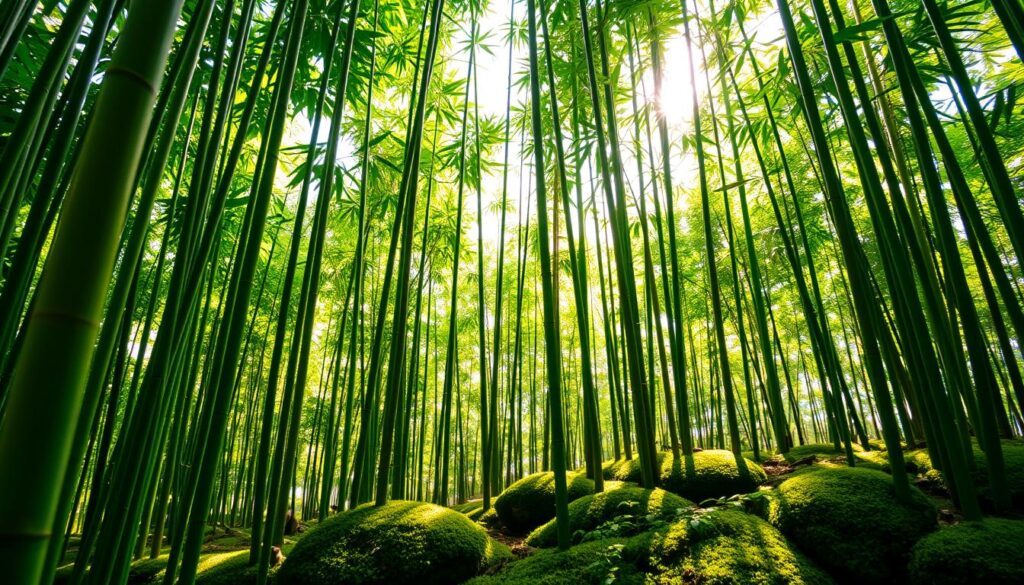
Bamboo forests are amazing at fixing and making ecosystems better. Their roots hold the soil in place, stopping erosion and landslides. They also soak up water, helping with water management and filling up aquifers.
Water Management and Aquifer Recharge
One hectare of Guadua bamboo can hold about 30,000 liters of water. This helps solve water shortages by boosting groundwater. Bamboo forests are key for keeping water flowing, helping communities stay hydrated.
Biodiversity Conservation
Bamboo forests are also great for many species. They’re homes for insects, reptiles, and birds like the spotted bamboowren and white-bearded antshrike. These birds live mainly in big bamboo forests. Bamboo also brings back life to rivers, supporting many aquatic creatures.
Fixing bamboo forests is essential for a healthy ecosystem. They help with water, soil, and support many species. Bamboo forests are vital for keeping our planet healthy for future generations.
| Ecosystem Service | Bamboo Forests | Other Forests |
|---|---|---|
| Soil Conservation | 99% | 35-40% |
| Environmental Rehabilitation | 93% | N/A |
| Carbon Sequestration | 17 tons/ha/year | 2-4 times less |
“Bamboo forests have proven to be the best option for both landscape restoration and the supply of various ecosystem services, outperforming other types of planted forests in providing ecosystem services.”
Bamboo: A Sustainable Solution for Climate Resilience
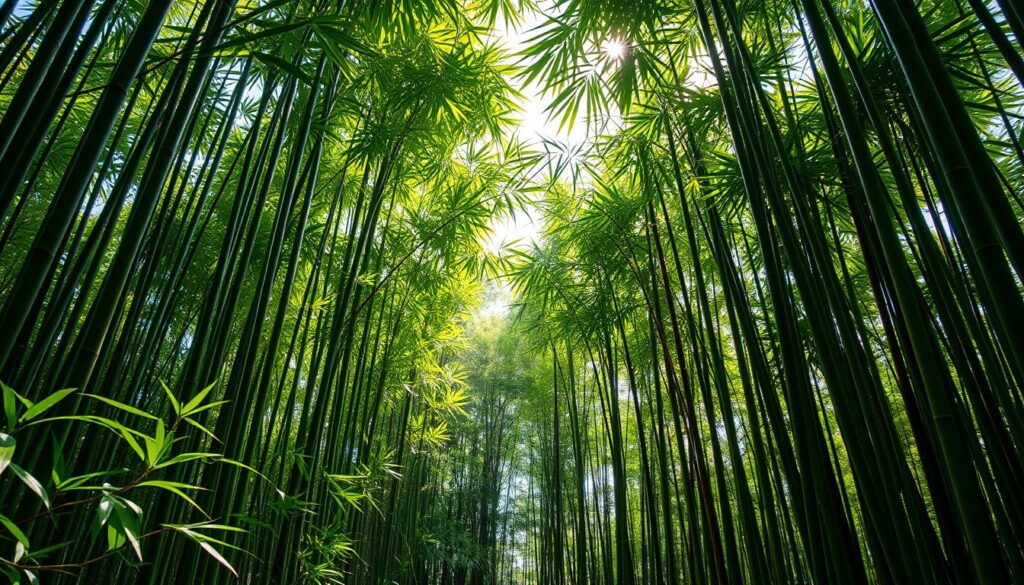
Bamboo is a versatile grass that grows well in many climates. It’s becoming a key player in the fight against climate change. Its fast growth and ability to absorb carbon make it a great choice for fighting climate change.
Climate Resilience and Carbon Sequestration
Bamboo grows quickly and strongly, helping to reduce greenhouse gas emissions. Planting 10 million hectares of bamboo could save over 7 gigatons of carbon dioxide in 30 years. This is more than what 300 million electric cars could save in the same time.
Bamboo can absorb carbon at a high rate. Moso bamboo forests can sequester 24.31 tCO2/ha annually. This is twice as much as Chinese fir and four times as much as Masson pine in similar areas.
Bamboo helps communities deal with extreme weather like floods and droughts. Its roots strengthen the soil, reducing landslides in rainy areas. Bamboo also bends in strong winds, protecting against storm surges.
Community Empowerment and Livelihoods
Growing bamboo can help local communities financially. They can make bamboo products like handicrafts, furniture, and building materials. Worldwide, 2.5 billion people rely on bamboo, and in China, nearly 10 million work in the bamboo industry.
Using bamboo can lead to a future where everyone wins. We can have climate resilience, carbon sequestration, and community growth together. This creates a more sustainable and fair world.
Also Read : Red Panda Food: What Keeps Them Healthy
Conclusion
Bamboo is a giant grass with huge potential for sustainable living and environmental conservation. It’s used in many ways, like building materials, clothes, and crafts. It also helps restore nature and fight climate change.
This shows us what’s possible with renewable resources. We can make a big difference by using bamboo wisely.
Exploring bamboo’s endless uses is key. We need to grow it sustainably and empower our communities. This way, we can protect our planet and make it better for everyone.
Starting a greener future is all about bamboo. By growing it right, creating new products, and loving nature, we can build a better tomorrow. Let’s make it happen for our planet and all living things.
FAQs
Q: What is the Shunan Bamboo Forest known for?
A: The Shunan Bamboo Forest is renowned for its stunning landscapes and diverse species of bamboo. Located in China, this beautiful bamboo forest offers visitors a unique opportunity to explore the vast bamboo stands and experience the tranquility of nature.
Q: Where can I find the famous Arashiyama Bamboo Forest?
A: The Arashiyama Bamboo Forest is located in Kyoto, Japan. This iconic bamboo grove is famous for its towering bamboo stalks and serene pathways, making it a popular destination for nature lovers and photographers.
Q: What types of bamboo are commonly found in the bamboo forests of China?
A: China is home to various bamboo species, including Moso bamboo, which is widely cultivated for its strength and versatility. Other species of bamboo can also be found in China’s bamboo forests, contributing to the rich biodiversity of these natural forests.
Q: How does bamboo contribute to carbon sinks?
A: Bamboo plants have a high carbon stock capacity, making them effective carbon sinks. They absorb carbon dioxide from the atmosphere, helping to mitigate climate change while providing a sustainable resource for various uses.
Q: Are there any bamboo forests in Nepal?
A: Yes, Nepal has several bamboo forests that are rich in biodiversity. These bamboo plantations not only provide essential resources but also support local wildlife, including the red panda.
Q: What are some benefits of bamboo for the environment?
A: Bamboo offers numerous environmental benefits, including soil erosion prevention, carbon sequestration, and the restoration of degraded lands. Additionally, bamboo’s rapid growth makes it an excellent renewable resource.
Q: How can I plant bamboo in my garden?
A: To plant bamboo, choose a suitable species based on your climate and soil conditions. Prepare the planting area by ensuring good drainage and ample sunlight. Dig a hole for the bamboo plant, place it in the hole, and water it adequately to promote healthy growth.
Q: What role do pandas play in bamboo forests?
A: Giant pandas primarily rely on bamboo as their main food source. Their diet consists almost entirely of bamboo leaves and stems, which makes bamboo forests crucial for their survival. Similarly, the red panda also depends on bamboo for sustenance.
Q: What is the International Bamboo and Rattan Organisation?
A: The International Bamboo and Rattan Organisation is an international body that promotes the use of bamboo and rattan for sustainable development. It aims to enhance the potential of bamboo as a resource for various applications while supporting ecological conservation.
Source Links
- https://www.ollegardens.com/blogs/news/celebrating-natures-green-giant-world-bamboo-day?srsltid=AfmBOopyrN1KTq1rsLltjJ9hHaNguOHe-U5CREHImvsnBHugnvzm3fZD
- https://csuiteafrica.com/csuite/natures-green-guardians-bamboo-in-climate-resilience/
- https://www.oneearth.org/the-wonders-of-bamboo-groves/
- https://pandalondon.com/blogs/sweet-dreams-blog/wonderful-world-of-bamboo-plant
- https://studycli.org/chinese-culture/chinese-bamboo/
- https://discovermagazines.com/issues/post/kyoto-its-highlights-and-natural-beauty-of-the-bamboo-forest/

